Recent excavations at Teklanika West have yielded new data on site chronology and human occupation history. The archaeological site is located in Denali National Park and Preserve (Denali) and is situated on a loess-mantled granitic bedrock bluff overlooking the glacial-fed Teklanika River.
Introduction
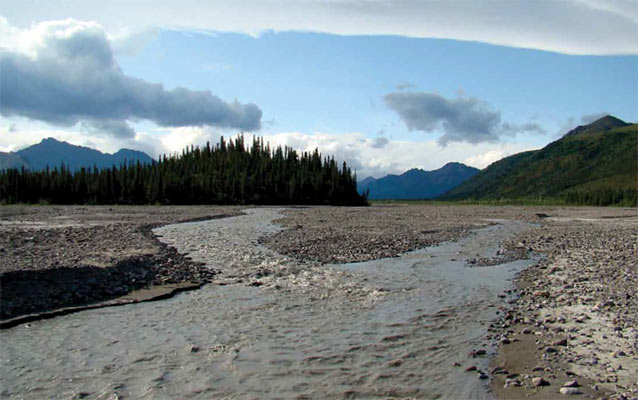
S. Coffman
Recent excavations at Teklanika West have yielded new data on site chronology and human occupation history. The archaeological site is located in Denali National Park and Preserve (Denali) and is situated on a loess-mantled granitic bedrock bluff overlooking the glacial-fed Teklanika River (Figure 1).
Significant research has taken place at the site by other investigators since the early 1960s (cf. Goebel 1992, 1996, Morgan 1965, Treganza 1964, West 1965, 1967, 1975, 1996), due to the site’s location and relatively easy access. These early investigations were largely surface collections of artifacts near the edge of the bluff. However, Fredrick H. West did conduct a series of small excavations at the site (Figure 2).
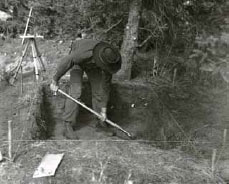
NPS Photo
Based on these excavations, West interpreted the site to contain two large occupations (also referred to in this paper as components). The first was an undated occupa-tion with numerous artifacts and some large mammal bones, likely moose (Alces alces) (West 1996). The second, and older underlying component, was a single undated large occupation, characterized by a microblade-rich assemblage with no associated fauna (West 1965, 1975).
This assemblage along with several other sites in interior Alaska was used by West to define the Denali culture complex dating to approximately 10,000 years before present (B.P.). West’s definition of the complex included bifaces, microblades, and wedge-shaped cores (West 1975). It is important to note that later excavations at the Dry Creek site north of Healy refined West’s definition and ultimately became the type-site for the Denali culture complex. Interestingly, there was an older occupation.
Artifacts from this occupation were used to define the Nenana culture complex. The most important aspect of the Nenana complex is that it lacks microblades and microblade technology. A brief re-investigation of the site by Ted Goebel in 1992 yielded artifacts within a profile and stratigraphically associated radiocarbon dates (1992, 1996). The dates and artifacts indicated the site has multiple occupations ranging in age from the early Holocene (~10,000 years) to late Holocene (last 1,000 years).
Goebel’s investigations indicated Teklanika West was more complex than originally interpreted. His research suggested there might be faunal remains associated with the oldest component at the site. Given the two competing ideas, the 2009 ex-cavations at the site focused on exploring basic questions concerning the site chronology, component (occupation) delineation, technological organization, and subsistence activities (if possible) based on faunal remains.
Stratigraphy
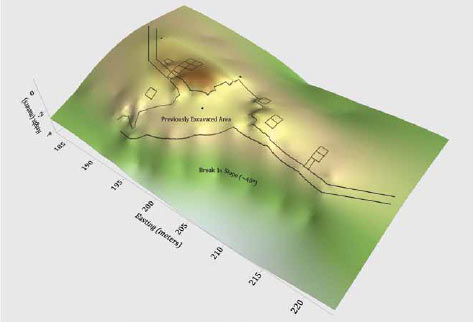
Block excavation was conducted at the site with blocks spaced approximately 16.5 feet (5m) apart to better address site formation and disturbances across the site and landform (Figure 3).
The upper Teklanika River valley was glaciated during the late Pleistocene (Figure 4) (Warhaftig 1958); however, no evidence of glacial activity (e.g. glacial till) was observed during the excavations, confirming the bluff the site occupies is solid bedrock and not glacially related.
Excavations showed the stratigraphy of the site consists of ~20-47 inches (~50-120 cm) of aeolian silt and sand; sediments, soils, and dates are illustrated in Figure 5. There are taphonomic disturbances at the site in the form of cryoturbation (frost churning, the result of movement in soil due to freezing and thawing). This was particularly noticeable in the upper sediments - the O, A, and B horizons.
A tephra of an unknown source (not the locally known Jarvis Creek ash) is relatively continuous across the site at ~16” (~40 cm) below the modern surface. The C horizon is comparatively intact and lies atop bedrock. Radiocarbon dating illustrates a secure chronology for the site, including the Oshetna tephra (6,502-7,156 years ago) (Addison and Beget 2010) above a paleosol or former soil.
Component Delineation
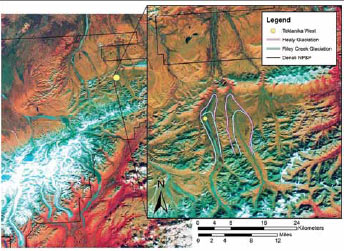
After Wahrhaftig 1958; digitized by S. Coffman
The 2009 excavations showed that the site was more complex than both researchers had originally thought. There was considerable evidence that the site contained multiple components. Tentative component delineations are based on bone-collagen dating of animal taxa associated with lithic artifacts, stratigraphic association, and material type distributions.
The two lowest components (illustrated as C1 and C2) appear spatially separated, below the paleosol. Component 1 is associated with a Bison sp. and has been dated to about 12,600-13,100 years old. It contains two broken bifaces (Figure 6) and a side scraper. This component is unique because it dates to the initial Younger Dryas period (a cool, dry period in the Earth’s climate history dating from about 12,800-11,500 years ago) (Mangerud et al.1974, Meltzer and Holliday 2010).
This is a period with very few archaeological components in eastern Beringia, and may represent a transition between the older Nenana and younger Denali culture complexes.
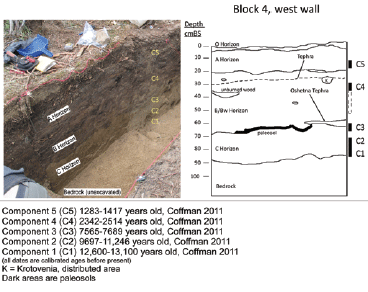
Component 2 is dated to the early Holocene, 9,697- 11,246 years old, and also associated with bison (Bison sp.). This component contains the highest number of tools recovered from the site.
Tools from this component include three strongly convex lanceolate projectile point bases (Figure 6), two end scrapers, two broken bifacial performs, and two microblades. Component 3 is directly associated with the paleosol of the site. Direct dating of charcoal from the paleosol puts the age of this component to between 7,565-7,689 years old. Artifacts from this component include two bipointed lanceolate projectile points (Figure 6), three boulder spall scrapers, highly fragmented faunal remains (none of which were identifiable), and microblades.
There were four obsidian microblades recovered from this component (Figure 7). Each of these microblades has been geochemically sourced to the Batza Tena obsidian source located near the Indian River, a tributary of the Koyukuk River. The source itself is located approximately ~200 miles (~320 km) from the site, implying the obsidian was either traded or directly procured. Identification of charcoal from the paleosol has been identified as spruce (Picea sp.).
Spruce is one of the predominate tree species that makes up the boreal forest, and the presence of spruce within the paleosol and at this age would imply that the boreal forest had or was in the process of being established in the upper Teklanika River valley.
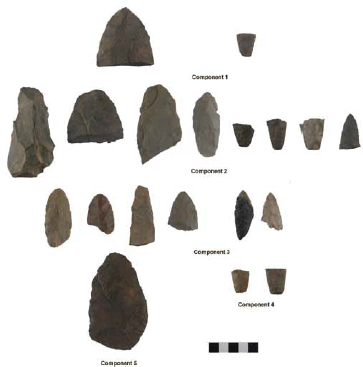
Ben A. Potter
Component 4 at Teklanika West dates to between 2,342-2,514 years old. This component contains caribou (Rangifer tarandus) remains. This component shows considerable continuity with Athabaskan subsistence practices. Tools from this component include two lanceolate projectile point bases (cf. Figure 6).
These bases share many affinities to those from component 2 and likely represent post depositional disturbance or movement of these artifacts, since both were found in a rodent burrow. The last and youngest component represented at the site dates to the late Holocene, about 1,283-1,417 years old. Component 5 contains Dall’s sheep (Ovis dalli) remains. Similarly to component 4, component 5 shares a link to Athabaskan subsistence practices and neither component contains microblades.
Based on these most recent excavations at the site, with modern techniques, these data demonstrate the presence of multiple components, including one dating to the late Pleistocene. The relative lack of a microblade industry at the site might relate to the small sample size at present, but the presence of microblades in small samples in components 2 and 3 are consistent with regional continuity of this technology (Potter 2008).
There were no Nenana complex diagnostic materi-als (tear-dropped shaped projectile points) found in any of the components (Goebel et al. 1991). Bison remains were present at the site during and after the Younger Dryas. Coupled with the bison found at the intermediate Dry Creek component 2 (~11,400-12,200 years old) (Powers et al. 1983), this suggests that bison were a reliable resource in the northern foothills of the Alaska Range during and after the Younger Dryas. This strategy in subsistence differs significantly from the later Holocene components that are associated with modern upland ungulates (sheep and caribou).
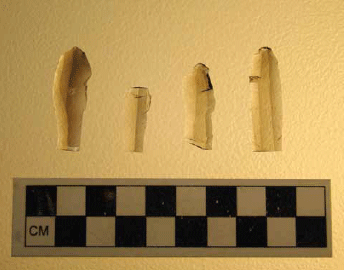
S. Coffman
Current interpretations of two distinct cultural traditions (Nenana and Denali complexes) in interior Alaska separated by the Younger Dryas are more difficult to sustain given older microblade technology at sites in the Tanana River valley (e.g. Swan Point (Holmes 2001) and younger Chindadn points in Cultural Zone 3 at Swan Point (Holmes 2008)).
Interpretations of the Teklanika West data seem to indicate microblade technology was not a key focus at the site. Rather, tool refurbishment and biface production seems to have played larger roles at the site. However, it is still unclear, at present, how the Teklanika West data fits into the broader cultural chronology of the region. What is clear is that a single microblade-rich Denali complex occupation at the site is shown to be incorrect.
Additionally, given the new dating of the site, it is now the oldest archaeological site in Denali National Park and Preserve. The site has assisted greatly to elucidate lifeways of early populations in upland regions of the foothills region of central Alaska.
Acknowledgements
Funding for this project came from Denali National Park and Preserve. Additional financial support was pro-vided by the Otto Geist Fund at the University of Alaska Museum of the North and by the Murie Science and Learning Center Discover Denali Fellowship Program.
Ben A. Potter (UAF), Jeremy Karchut (NPS Regional Office), Amy Craver, and Lucy Tyrrell (both from Denali National Park and Preserve), all provided their support and assistance of this project. Thanks to the volunteers who helped with excavations. Jacob Adams and Elizabeth Mikow provided comments and feedback for this paper.
References
Addison, J., and J. Beget. 2010.
Tephra analysis report summary: Teklanika West archaeological site. Report submitted to the author 2010.
Coffman, S.C. 2011.
Archaeology at Teklanika West (HEA-001): An upland archaeological site, central Alaska. Unpublished M.A. Thesis. University of Alaska Fairbanks.
Goebel, T. 1992.
Geoarchaeological Research at Teklanika West, Denali National Park, Alaska. Preliminary Report submitted to the National Park Service, Alaska Support Office. Anchorage, AK
Goebel, T. 1996.
Recent Research at Teklanika West: Site Stratigraphy and Dating. In American Beginnings: The Prehistory and Paleoecology of Beringia, edited by F.H. West, pp. 341-343. University of Chicago Press. Chicago.
Goebel, T., W.R. Powers, and N. Bigelow. 1991.
The Nenana Complex of Alaska and Clovis Origins. In Clovis: Origins and Adaptations, edited by R. Bonnichsen and K.L. Turnmire, pp.49-79. Center for the Study of the First Americans, Oregon State University. Corvallis, Oregon.
Holmes, C.E. 2001.
Tanana River Valley Archaeology Circa 14,000 to 9000 B.P. Arctic Anthropology 38(2): 154-170.
Holmes, C.E. 2008.
The Taiga Period: Holocene Archaeology of the Northern Boreal Forest, Alaska. Alaska Journal of Anthropology 6(1-2): 69-81.
Mangerud, J., S.T. Andersen, B.J. Berglund, and J.J. Donner. 1974.
Quarternary stratigraphy of Norden, a proposal for terminology and classification. Boreas 3: 109-128.
Meltzer, D.J., and V.T. Holliday. 2010.
Would North American Paleoindians have Noticed Younger Dryas Age Climate Changes? Journal of World Prehistory 23: 1-41.
Morgan, H.M. 1965.
An Archaeological Survey of Mount McKinley National Park. U.S. Department of Interior, National Park Service. Contract 14-10-0434-951.
Potter, B.A. 2008.
Radiocarbon Chronology of Central Alaska: Technological Continuity and Economic Change. Radiocarbon 50(2): 181-204.
Powers, W.R., R.D. Guthrie, and J.F. Hoffecker. 1983.
Dry Creek: Archaeology and Paleoecology of a Late Pleistocene Alaskan Hunting Camp. Report submitted to the National Park Service. Contract No. CX-9000-7-0047.
Treganza, A.E. 1964.
An Archaeological Survey of Mount McKinley National Park. University of Alaska and U.S. Department of the Interior, National Park Service. Contact No. 14-10-0434-1547.
Wahrhaftig, C. 1958.
Quaternary geology of the Nenana River valley and adjacent parts of the Alaska Range. US Geologic Survey Professional Paper 293-A.
West, F.H. 1965.
Excavations at Two Sites on the Teklanika River, Mount McKinley National Park, Alaska. Report to the National Park Service. University of Alaska. College, Alaska.
West, F.H. 1967.
The Donnelly Ridge Site and the Definition of an Early Core and Blade Complex in Central Alaska. American Antiquity 32(3): 360-379.
West, F.H. 1975.
Dating the Denali Complex. Arctic Anthropology 12(1): 76-81.
West, F.H. 1996.
Teklanika West. In American Beginnings: The Prehistory and Paleoecology of Beringia, edited by F.H. West, pp. 332-341. University of Chicago Press. Chicago.
Part of a series of articles titled Alaska Park Science - Volume 12 Issue 1: Science, History, and Alaska's Changing Landscapes.
Last updated: August 14, 2017
